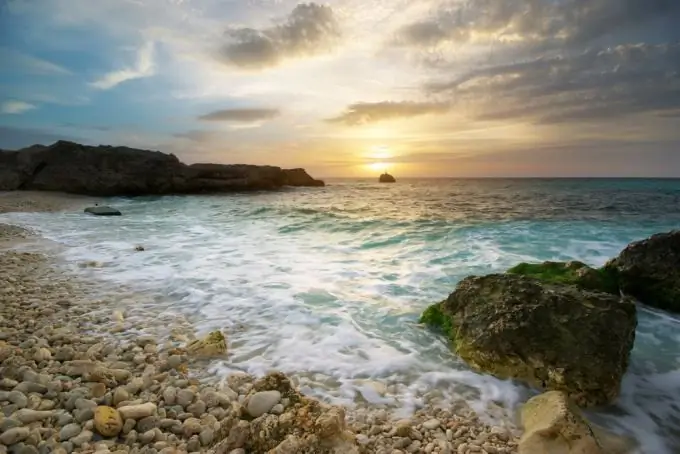On a summer day, the sea constantly changes its color from bright blue to emerald green and dark turquoise. There is nothing surprising in the fact that artists again and again return to the theme of the sea, trying to capture the magic of waves and light on canvas.

It is necessary
Canvas stretched on a board measuring 41 * 51 cm, brushes: round No. 4, flat No. 6, 8 acrylic paints: phthalocyanine blue, phthalocyanine green, burnt sienna, yellow cadmium, blue azure, titanium white, light cadmium red, ultramarine
Instructions
Step 1
We draw the reference lines. Mix equal amounts of phthalocyanine blue paint and burnt sienna, diluting the mixture to the consistency of water. Using a # 4 brush, paint a nine mesh grid onto the canvas to help you scale to the scale of the composition. Sketch the composition of the future painting - mark the horizon line, which should be about a third from the top edge of the canvas, and the soft curve of the beach.
Step 2
Apply the basic colors. Take a flat brush number 6 and outline the main areas of color. Cover the hills with a layer of yellow cadmium added to a mixture of phthalocyanine blue paint and burnt sienna. Paint over the sea in the foreground with long horizontal strokes of phthalocyanine blue, thinned to the consistency of liquid cream.
Step 3
We mix paints for the sky and sand. Paint over the sky with a mixture of equal parts azure blue and phthalocyanine blue with a drop of white. To paint a flat beach surface, mix white with cadmium yellow and burnt sienna and paint in horizontal strokes.
Step 4
We write the waves rolling onto the beach. To paint waves in shallow water, mix turquoise paint, adding a little green paint and burnt sienna to the whitewash. The movement of the waves will help convey horizontal strokes of paint.
Step 5
We write water. The distant, cold tones of the sea should be painted with a thick mixture consisting of one-third of phthalocyanine blue paint and two-thirds of white. Apply the paint in horizontal strokes, and folds will appear between the strokes, depicting individual waves of the sea. As you move down the canvas, gradually add phthalocyanine green paint to the mixture to deepen the tone.
Step 6
We write surf. Mix a drop of phthalocyanine green paint with undiluted whitewash to paint foamy wave crests with this mixture. Apply paint along the edge of the surf.
Step 7
Shade the waves. Using the # 6 brush, paint dark turquoise shadows on the bottom of the ox. To obtain the desired color, mix about two-thirds of the white with one-third of the phthalocyanine blue paint and add a drop of phthalocyanine green paint. Now the seascape can be considered as a whole complete.






